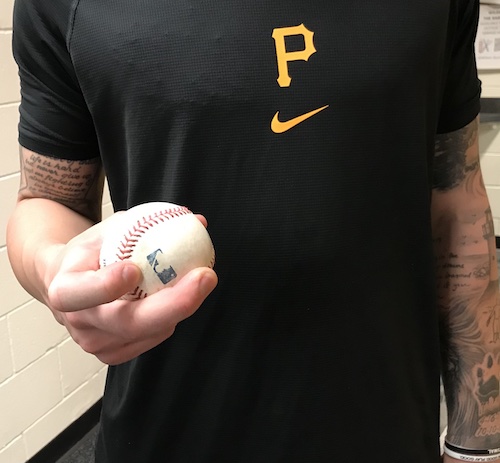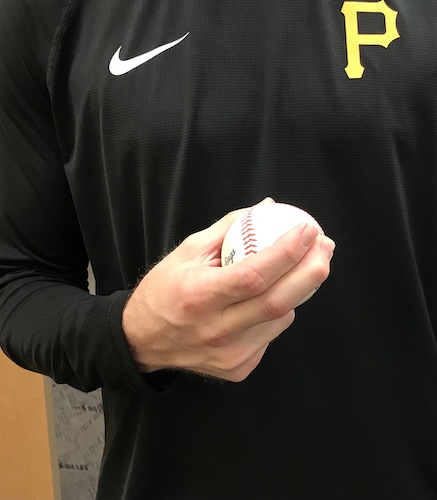Mike Burrows and Chris Stratton on Learning, Developing Their Curveballs

The Learning and Developing a Pitch series is back for another season, and once again we’re hearing from pitchers on a notable weapon in their arsenal. Today’s installment features a pair of Pittsburgh Pirates on their quality curveballs; Chris Stratton is one of the club’s back-end relievers, and prospect Mike Burrows is rated by Baseball America as having the best breaker in the system.
———
Michael Burrows, Pittsburgh Pirates
“My dad said I couldn’t even try to throw a curveball until I had hair under my armpits; that was the saying for him. But yeah, I really started as soon as I could, maybe at 13 or 14, and then just developed feel for it. As I got older — as I continued to progress — I had to change the shape of it, because as hitters got better I couldn’t have a curveball that was popping out. So it’s really been an evolution of a curveball that was in the low-to-mid 70s and has creeped up into the low 80s. It’s sharper now.
“I would say it [improved the most] over COVID, and then as I got into the 2021 season. That spring training, I really started working on building intent and throwing it harder. Metrically, when you look at a curveball that’s over 80 mph, it’s significantly harder to hit — hitters’ numbers go down — and I think that was the biggest turning point for me. Throwing it harder, there’s not a huge decrease in break, but a better shape to where it tunnels my fastball better.
“[Prior to 2020], I didn’t have Rapsodo, TrackMan, or anything like that. Right before COVID hit, about a month until that spring training, I went out and got a Rapsodo. I started diving into the metrics of pitches — why some are better than others, what spin direction was going to do for me. That’s when I really started developing my curveball. I was also throwing with a guy from the Dodgers, Nolan Long — he’s since signed with Athletics — and they have endless amounts of information over there. Another thing I did was take the Rapsodo course, so I could better understand all of the numbers.

“In terms of adjustments, it wasn’t really mechanics; it was more so thinking about that last five percent, rather than the entire motion. It’s about keeping my body under control, and then in that explosion, when I’m really throwing the baseball, is when the effort happens. It’s like a karate-chop motion, where your hand is staying neutral through the throw. It’s that last bit, where the hand is coming through and it rolls over top.
“The curveball was always there for me. It’s not like it had bad spin or anything like that. Everything was there. All I needed was to find a better shape that was going to tunnel my fastball. I still want that 12–6; I still want that vertical break to it. Again, I want to be able to tunnel it, not have it pop out.”
———
Chris Stratton, Pittsburgh Pirates
“A curveball was the first off-speed pitch I ever learned — I didn’t learn a changeup or a slider until a lot later on — so it was probably when we were first able to throw a breaking ball. I guess it would have been around age 10 or 11. I know that I always tried to make it really big and loopy. I thought that was what you wanted, the most movement possible. When you’re a little kid, you’re playing catch and you throw a curveball that looks like it’s going to sail over his head, and it ends up landing in front of him. We used to think that was funny.
“As for who showed me a grip, I couldn’t tell you. But I do know that I only had two pitches coming out of high school, a fastball and a curveball. So much has changed since I was young. My mechanics weren’t what they are now. I used to move my head a lot and try to throw straight over the top. My curveball used to be more 12–6, straight up and down.
“I’d say I changed probably around my sophomore year in college, or maybe my junior year. It had a lot to do with my pitching coach at the time, Butch Thompson. He’s the head coach at Auburn right now. He wanted me to throw something that was a little bit smaller, so he presented me with what is basically a slider. But he told me it was a cutter. That was so I’d have a thought process of how to throw it like that, and in doing so I got my hand more out front. It helped my heater as well, and my curveball took a different shape. Trying to stay on top with a slider, I got my head in a better position to be more linear than it was in the past.

“You have to think of every pitch like it’s like you’re throwing a fastball. In the past, there was such a separation between ‘Here’s my fastball’ and ‘Now I’m going to throw a curveball.’ That’s why it was bigger and slower. My first year of college, I think it was like 72–73 [mph], and now it’s 78–81. The shape it’s taken is different than it was. Adding the slider kind of created that mentality for everything.
“My junior year of college, I was throwing fastball/curveball/slider/changeup, although I rarely threw the change. Sometimes I would attack hitters with just fastball/slider, and then sometimes I just did fastball/curveball, depending on which one was working. I don’t know if there was ever a specific time where I was like, ‘Hey, my curveball is elite.’ I thought it was just another one of my pitches. It probably took me getting to the big leagues to realize that it was actually better than I thought it was.
“I think I got drafted because of my slider. It was more or less my bread-and-butter coming out of college, with me mixing in the curveball. When [scouts] would ask me to rank my pitches in order, it would have been fastball, slider, curveball, change. But once I got to the big leagues — this was with the Giants, in 2016 — the swings-and-misses I was getting were mostly on my curveballs. Even then, it was more 75 [mph], but I think a lot of that had to do with how my body was moving through space. It’s harder now, with a good combination of horizontal and vertical.”
David Laurila grew up in Michigan's Upper Peninsula and now writes about baseball from his home in Cambridge, Mass. He authored the Prospectus Q&A series at Baseball Prospectus from December 2006-May 2011 before being claimed off waivers by FanGraphs. He can be followed on Twitter @DavidLaurilaQA.
Thanks for this article–I really enjoyed it and the two offered a nice contrast of how they developed their elite curveballs.